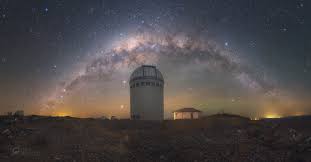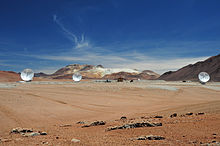Atacama Large Millimeter Array

The Atacama Large Millimeter/submillimeter Array (ALMA), an international association between Europe, North America and East Asia, in collaboration with the Republic of Chile, is the world's largest astronomical project. 2 3 This is a revolutionary interferometer that It comprises a set of 66 antennas (also called antennas: reflectors or radio telescopes when it is a single antenna) of seven and twelve meters in diameter intended to observe millimeter and submillimeter wavelengths. The project was built in the plain of Chajnantor, at 5058.7 meters altitude, in the Atacama desert, in the northern part of Chile. With a cost of more than 1 billion euros, it is the largest and most expensive built-in terrestrial telescope.
The soul is expected to envision the formation of the stars at the dawn of the universe and to obtain extremely detailed images of stars and planets in the process of birth. ALMA began astronomical observations during the second semester of 2011 and the first images were published in the press on October 3, 2011. The inauguration of the project took place on March 13th, 2013.

ALMA forms a unique radiotelescopio6 of revolutionary design, initially composed of 66 high-precision antennas operating at wavelengths of 0.3 to 9.6 mm. The set has a sensitivity and resolution far superior to those of existing submillimeter radio telescopes such as the single-reflector James Clerk Maxwell or the other interferometric networks such as the Submillimeter Array or the Bure Plateau Observatory of IRAM.
The antennas can travel in the desert traversing distances ranging from 150 m to 16 km, which provides ALMA with a powerful variable "zoom", operating similar to the VLA in New Mexico, United States.
The great sensitivity is mainly due to the 66 antennas that the set has.
The antennas are provided by the European, American and Asian partners of ALMA. The North American and European partners already commissioned 25 12-metre diameter antennas, which make up the main set. East Asia provided 16 antennas (4 of 12 meters in diameter and 12 of 7 meters) that form the compact Atacama complex (ACA) and will join the extended ALMA project.
Using these smaller antennas in the ACA, you can generate images from larger areas to certain frequencies. The fact of being able to bring them closer also allows to generate images of sources with greater angular extension. The ACA will work with the main set to increase the capacity of the latter to generate images of large areas.

History
Alma Antenna prototypes in the ALMA test facility.
Operations Center.
File: The movie ALMA — In Search of our Cosmic origins. OGV
The 16-minute video presents ALMA's story-from the origins of the project, a few decades ago to the latest scientific discoveries. (In HD, English, Spanish subtitles.)
ALMA was born from a fusion of ideas from three astronomical projects: the millimeter Array (MMA, ' conjunto millimeter ') of the United States, the large southern Array (LSA, ' Great South Ensemble ') of Europe and the Large Millimeter array (LMA, ' Great Millimeter Ensemble ') of Japan . In 1997, the big step took place when the European Southern Observatory (ESO) and the National Radio Astronomical Observatory (NRAO) agreed to start a project that would combine the MMA and the LSA in a single venture , which would later be baptized as ALMA. The project combined the sensitivity of the LSA with the frequency coverage and the superior altitude of the MMA. That and NRAO worked together in technical, scientific and management groups to define and organize a joint project, adding the participation of Canada and Spain (which was not part of that at the time).
This decision followed a series of resolutions and agreements, including the election, in March 1999, of the "Atacama Large Millimeter Array" (ALMA), as the name of the project. These efforts culminated in the signing of the agreement that ALMA instituted on 25 February 2003 between North American and European parties. After several years of negotiation, the ALMA project received a proposal from the National Astronomical Observatory of Japan (NAOJ) to provide the Atacama compact ensemble (ACA) and three additional band receivers for the Main set, thus extending the ALMA project. The negotiations between Alma and NAOJ resulted in the signing of a high-level agreement on September 14, 2004 that marked the official entry of Japan to the Alma extended project, called since the Atacama Large Millimeter/submillimeter Array.
During the first stages of ALMA planning, it was decided to commission the construction of the antennas to different reputable companies in North America, Europe and Japan, rather than just one design, mainly due to political reasons. Although suppliers have used very different methods, each of the designs presented seems to meet the strict requirements of ALMA.
In 2016 the project was complemented with band 5 receivers, which allow to improve the observation capacity of radio waves with wavelengths of 1.4 to 1.8 millimeters, enhancing the capacity to observe water.
Este Post ha recibido un Upvote desde la cuenta del King: @dineroconopcion, El cual es un Grupo de Soporte mantenido por 5 personas mas que quieren ayudarte a llegar hacer un Top Autor En Steemit sin tener que invertir en Steem Power. Te Gustaria Ser Parte De Este Projecto?
This Post has been Upvote from the King's Account: @dineroconopcion, It's a Support Group by 5 other people that want to help you be a Top Steemit Author without having to invest into Steem Power. Would You Like To Be Part of this Project?
Buen post el que compartes, aunque mi traduccion no es muy buena me gusto bastante el artículo
Congratulations! This post has been upvoted from the communal account, @minnowsupport, by jonjro from the Minnow Support Project. It's a witness project run by aggroed, ausbitbank, teamsteem, theprophet0, someguy123, neoxian, followbtcnews, and netuoso. The goal is to help Steemit grow by supporting Minnows. Please find us at the Peace, Abundance, and Liberty Network (PALnet) Discord Channel. It's a completely public and open space to all members of the Steemit community who voluntarily choose to be there.
If you would like to delegate to the Minnow Support Project you can do so by clicking on the following links: 50SP, 100SP, 250SP, 500SP, 1000SP, 5000SP.
Be sure to leave at least 50SP undelegated on your account.